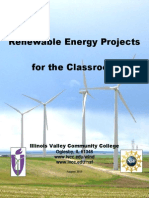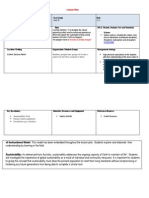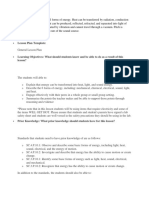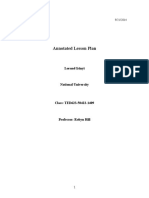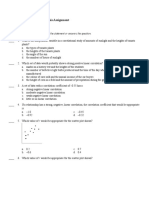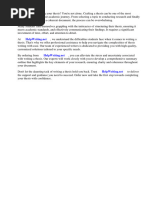Jarosz Demonstrationlessonplan
Jarosz Demonstrationlessonplan
Uploaded by
api-205383942Copyright:
Available Formats
Jarosz Demonstrationlessonplan
Jarosz Demonstrationlessonplan
Uploaded by
api-205383942Original Title
Copyright
Available Formats
Share this document
Did you find this document useful?
Is this content inappropriate?
Copyright:
Available Formats
Jarosz Demonstrationlessonplan
Jarosz Demonstrationlessonplan
Uploaded by
api-205383942Copyright:
Available Formats
Consumer Appliances and the Environment
Learning Objective: Students will measure the energy consumption of some basic household appliances Students will create a visual representation of the potential energy reductions they can make Students will identify the types of gasses associated with the production of electricity (carbon dioxide, carbon monoxide, sulfur dioxide, nitrogen dioxide)
Assessment Criteria: Students will collect data from their homes about energy usage Students will create a presentation representing their carbon outputs Students will identify the listed waste gasses above
Standard: NGSS MS-ESS3-i: Use visual representations of system models to support explanations of how human activities significantly impact the atmosphere Prior Knowledge: Students will have already moved through information about the Earths greenhouse effect. Students will understand an increase in the amount of greenhouse gasses in the atmosphere correlates to increased temperatures and global climate change. Students will add to this knowledge by finding out how their own electricity usage is compared to these large, general figures. Students will understand concept of conservation of matter. Instructional Strategies: In this lesson, I will demonstrate the energy consumption of common household appliances in real time. This will be accomplished by the use of an energy meter, such as the commercially available Kill a Watt (available through amazon and other retailers for <$20). Materials and set-up: Board/projector Kill a Watt Lamp Traditional light bulb CPF light bulb LED light bulb Television Candle
Time Required: 2 class periods of about 50 minutes
Instructional Sequence: Day One: 1) Introducing the lesson Greet students as they walk in. When students take their seats and the bell rings, students should begin working on the warm up problem on the board: How do greenhouse gasses affect the environment? Students will write down their responses and hand them in. Anticipated responses: Greenhouse gasses hold in more of the heat from the sun. The gasses insulate the Earth. The gasses hold the Earths heat in. Tell the students to take a minute or two to discuss their responses with neighbors, and allow collaboration time. Then, gather the students attention and discuss the problem. 2) Body of the lesson Allow the students to remain in their groups but gather their attention. Light a candle at the front of the room, and ask students, What will happen if I let this candle burn all day. Anticipated response: The wax will melt and the candle will burn away. Ask the students, Where does the wax go? Is it gone forever? Anticipated responses, it all burns up, it is transformed into heat. If the students do not come to the conclusion that the candle must turn into other substances, ask Can matter ever be destroyed? Students should remember that matter cannot be created or destroyed, and then should be guided to the response that the wax turns into gasses like carbon dioxide when burned. Next, plug the lamp into the wall while in full view of the students. Ask the students where the energy that creates the light comes from. Anticipated responses the electrical wires, coal, a power plant. Ask students what the differences between a power plant and the candle are. Students should identify that the candle turns stored energy in the wax into light and heat, whereas the power plant creates electrical power. Tell the students that for this reason, the amount of electricity we use also impacts the amount of greenhouse gasses we release. At this point, pass out the worksheet that will guide the students through their days activities. Students will observe and record different power drains for common appliances on one side. The second side of the worksheet will have a rubric for the home analysis project. Plug each one of the appliances (normal light bulb, compact fluorescent bulb, LED bulb, and television) into the Kill a Watt energy meter and record the energy draw when on and off (the television may draw some power even while off).
Ask the students to estimate how much of our energy is used to power lights and appliances. After students have made their estimates, bring up the projector and display the energy usage diagram found here: http://www.eia.gov/energyexplained/index.cfm?page=electricity_use The EIA (energy information administration) is a part of the EPA. The students will then be asked to identify what types of gasses are produced in the electric plants as well as how much carbon dioxide is produced. This information can be found on the eia site as well. http://www.eia.gov/tools/faqs/faq.cfm?id=77&t=11 Ask the students to read the remainder of the worksheet which will explain their homework and project. The worksheet will explain that the students are to record the number of hours each of the appliances tested (lights and TVs) are used in each of their homes. These appliances are easily used with lower frequency, or changed out for more efficient appliances (light bulbs). This data will be recorded over the course of a few days and averaged. Students will then calculate the carbon output from these devices in their households. Example: a traditional 100 watt light bulb operated four hours per day produces 63kg of carbon dioxide per year. Students will then complete their project by creating a visual representation of their annual carbon dioxide outputs; this could be drawings of comparable masses such as cars, trucks, houses, ect. Students will also be asked how much of this could be saved if they made certain changes (ex: reducing hours of television watched, or switching to more efficient bulbs). The values for carbon outputs for the different appliances should be calculated early by the teacher to match the appliances used. 3) Wrapping up the Lesson Remind students when the deadline for their project is, and remind them each day in class to make their hourly appliance usage estimates. 4) Evaluating Learning Evaluation will take place with the presentations of the projects.
Day 2: 2) Body of the lesson Students should come in ready to present their visual representations of carbon outputs. After students have presented their individual ideas, tell them to calculate the percentage reduction in carbon usage (1-lower value/higher value * 100%). Ask the students to again consider the total carbon dioxide emissions from electricity generation in the US in 2011 (2.116 billion metric tons, source EIA). Ask the students to calculate the reduction in carbon dioxide output if everyone in the U.S (population 300 million) implemented their solution. 4) Evaluation General rubric for grading worksheet/project: Grading Criteria: Student has correctly recorded the value of energy consumption for household appliances
Student has correctly estimated their household energy usage based on number of appliances listed Student correctly lists the gasses that are produced in the process of making electrical power in the U.S. Student creates and accurate physical representation (or drawing) of their carbon dioxide output
Design Rationale: The students do not completely meet the NGSS standard ESS3-I listed above in this lesson alone. Instead, this lesson was created to supplement and build on an existing understanding of greenhouse gasses and the Earths system. The study of the greenhouse effect takes place in phase one of our unit plan (unperturbed Earth systems-atmosphere, oceans ect). This lesson takes place within phase two of the Unit (human impact on these systems). The goal of this lesson is to personalize the information that students have taken it. It is easy for students of this age range to struggle with concepts dealing with enormous numbers such as those that are dealt with in earth and climate sciences. For this reason, this lesson was designed to create a meaningful connection with the students lives. Students can build off of their prior knowledge to see that each one of us is connected to climate change. This connection will be developed further in phase three of the unit (designing solutions to environmental problems) in which the students will use their knowledge from the previous two units to propose solutions to our energy needs that will are feasible for most people living in industrialized countries that will create a positive change on the environment.
You might also like
- Fly or Drive LabDocument6 pagesFly or Drive LabMrWardTeachesNo ratings yet
- Merton Truck Company AnalysisDocument11 pagesMerton Truck Company Analysiskrishna sharma100% (1)
- Lesson Plan - The Greenhouse EffectDocument4 pagesLesson Plan - The Greenhouse EffectYna Rhyss Erald RomsNo ratings yet
- Renewable Energy Projects - HandbookDocument72 pagesRenewable Energy Projects - HandbookWahyoe SiahaanNo ratings yet
- Mary Jackson Annotated BibliographyDocument2 pagesMary Jackson Annotated Bibliographyapi-254768340No ratings yet
- Stem434 Firstlessonplan DorothyfanninDocument17 pagesStem434 Firstlessonplan Dorothyfanninapi-375469242No ratings yet
- Esson Ow Do Humans Impact The Production of Greenhouse Gases VerviewDocument13 pagesEsson Ow Do Humans Impact The Production of Greenhouse Gases VerviewUrban EcoLab CurriculumNo ratings yet
- LP A New Angle On Solar Panel EfficiencyDocument11 pagesLP A New Angle On Solar Panel Efficiencyapi-325419298No ratings yet
- TitleGreenhouseGasesandClimateChangeEducatorGuidefromMITsTILclimate-1Document18 pagesTitleGreenhouseGasesandClimateChangeEducatorGuidefromMITsTILclimate-1mrsdaniwNo ratings yet
- Lesson PlanDocument5 pagesLesson Planapi-270170633No ratings yet
- Global WarmingDocument7 pagesGlobal WarmingButterfliesNo ratings yet
- Energy LessonDocument6 pagesEnergy LessonKristenBalchNo ratings yet
- Sample Lesson Plan For DemoDocument9 pagesSample Lesson Plan For DemoEdith Habig67% (3)
- Teacher Solar 2006Document16 pagesTeacher Solar 2006basura12345No ratings yet
- Energy Awareness 1 PlanDocument3 pagesEnergy Awareness 1 PlanrexcNo ratings yet
- Checkpoint Science Scheme of Work Physics - Year 1 Topic: Measurement AimsDocument9 pagesCheckpoint Science Scheme of Work Physics - Year 1 Topic: Measurement AimsvinuyeNo ratings yet
- M3 L7 FinalDocument8 pagesM3 L7 FinalUrban EcoLab CurriculumNo ratings yet
- Edsc 442c Ngss Dup Goals Objectives and AssessmentsDocument7 pagesEdsc 442c Ngss Dup Goals Objectives and Assessmentsapi-437045542No ratings yet
- Cini Dobro Sacuvaj Energiju Priprema Za Cas Srednja Ekonomska Skola Mirko Vesovic enDocument7 pagesCini Dobro Sacuvaj Energiju Priprema Za Cas Srednja Ekonomska Skola Mirko Vesovic enAdnan KusturaNo ratings yet
- Sustainable Architecture Lesson PlanDocument2 pagesSustainable Architecture Lesson Planapi-728719858No ratings yet
- Ngss Dup Goals Objectives and AssessmentsDocument7 pagesNgss Dup Goals Objectives and Assessmentsapi-398397642No ratings yet
- Electricity From The Sun: For Grades 4 and 5Document12 pagesElectricity From The Sun: For Grades 4 and 5Nyllirma CelayaNo ratings yet
- Lesson Plan: School Year Group DateDocument3 pagesLesson Plan: School Year Group Dateaashie24No ratings yet
- Apes Lampon SyllabusDocument11 pagesApes Lampon Syllabusapi-363636864No ratings yet
- Fruit Study ElectrochemistryDocument93 pagesFruit Study ElectrochemistryOmar EzzatNo ratings yet
- Title: Exploring Hydropower Grade Level: 10-12 Topic: Hydropower and Climate Change BackgroundDocument8 pagesTitle: Exploring Hydropower Grade Level: 10-12 Topic: Hydropower and Climate Change Backgroundapi-216116299No ratings yet
- Lesson Plan Template1 Sustainablitiy1Document2 pagesLesson Plan Template1 Sustainablitiy1api-242744371No ratings yet
- Lesson PlanP1Document5 pagesLesson PlanP1Orlando PraveshNo ratings yet
- Greenhouse PDFDocument9 pagesGreenhouse PDFWendy DiazNo ratings yet
- Renewable Nonrenewable Resources Lesson PlanDocument9 pagesRenewable Nonrenewable Resources Lesson Planapi-249704153No ratings yet
- Enst Renewable Energy Syllabus 2015 1Document6 pagesEnst Renewable Energy Syllabus 2015 1api-303214818No ratings yet
- Fannin Dorothy Lessonplan2 1Document21 pagesFannin Dorothy Lessonplan2 1api-375469242No ratings yet
- Electricity Consumption Project Review of LiteratureDocument8 pagesElectricity Consumption Project Review of LiteratureafmaadalrefplhNo ratings yet
- PHYS4400 OverviewDocument2 pagesPHYS4400 OverviewMICHAEL K. E. DonkorNo ratings yet
- Wind Turbine LessonDocument2 pagesWind Turbine Lessonapi-253728077No ratings yet
- Suhsd Draft Performance Task-Oct30 1-2Document2 pagesSuhsd Draft Performance Task-Oct30 1-2api-272743275No ratings yet
- Unit of WorkDocument8 pagesUnit of Workapi-378962710No ratings yet
- 5es Lesson Plan - SustainabilityDocument5 pages5es Lesson Plan - Sustainabilityapi-356491617No ratings yet
- Science 5-Electricity Unit Plan 1Document21 pagesScience 5-Electricity Unit Plan 1api-302777648No ratings yet
- Science - Energy Unit Lesson PlanDocument5 pagesScience - Energy Unit Lesson Planapi-232744621No ratings yet
- Lesson Plan Template:: o o o oDocument12 pagesLesson Plan Template:: o o o oJessa TiponesNo ratings yet
- Wind Power-Learning-ScenarioDocument7 pagesWind Power-Learning-Scenarioapi-414618110No ratings yet
- Ted690 Domain e Artifact 2 Lesson PlanDocument13 pagesTed690 Domain e Artifact 2 Lesson Planapi-320743991No ratings yet
- Energy Sources UnitDocument14 pagesEnergy Sources Unitapi-314241797No ratings yet
- L 8: C C E S M O:: How Do Our Food Choices Impact Energy Use?Document5 pagesL 8: C C E S M O:: How Do Our Food Choices Impact Energy Use?Urban EcoLab CurriculumNo ratings yet
- Lesson TemplateDocument7 pagesLesson Templateapi-279875556No ratings yet
- Investigating Solar EnergyDocument5 pagesInvestigating Solar Energyapi-251642500No ratings yet
- Homework Heat and The Conservation of EnergyDocument5 pagesHomework Heat and The Conservation of Energyafeuettkk100% (1)
- Electrical Circuits An Introduction Grade 4 Jessica DutcherDocument42 pagesElectrical Circuits An Introduction Grade 4 Jessica Dutcherapi-302628627No ratings yet
- Lesson Plan - Greenhouse WebquestDocument3 pagesLesson Plan - Greenhouse Webquestapi-265213613No ratings yet
- Lesson Plan 1Document5 pagesLesson Plan 1api-313895478No ratings yet
- L 2: T G E O:: What Is The Greenhouse Effect?Document5 pagesL 2: T G E O:: What Is The Greenhouse Effect?Urban EcoLab CurriculumNo ratings yet
- Tran Digital Unit Plan Template 2Document4 pagesTran Digital Unit Plan Template 2api-289524714No ratings yet
- Lesson Plan - Renewable EnergyDocument10 pagesLesson Plan - Renewable EnergychubbychubbyturtleNo ratings yet
- Lesson Plans May 9Document1 pageLesson Plans May 9Ginger Keahi DeCavitchNo ratings yet
- Developing A Free Energy Using A Magnet WithoutDocument11 pagesDeveloping A Free Energy Using A Magnet WithoutJohn Carlo Bacalando IINo ratings yet
- Best From Waste: Govt. Vidarbha Institute of Science and Humanities, Amravati Department of Physics and ElectronicsDocument4 pagesBest From Waste: Govt. Vidarbha Institute of Science and Humanities, Amravati Department of Physics and ElectronicsKiran SonawaneNo ratings yet
- Light Your Way - Design-Build A Series Circuit Flashlight - Activity - TeachEngineeringDocument8 pagesLight Your Way - Design-Build A Series Circuit Flashlight - Activity - TeachEngineeringDaeng HawangNo ratings yet
- Teaching Electrostatics: A Teacher's Resource for Increasing Student EngagementFrom EverandTeaching Electrostatics: A Teacher's Resource for Increasing Student EngagementNo ratings yet
- Sustainable Architecture: A Solution to a Sustainable Sleep-out Design Brief. Volume 2.: Sustainable Architecture - Sustainable Sleep-out Design Brief, #2From EverandSustainable Architecture: A Solution to a Sustainable Sleep-out Design Brief. Volume 2.: Sustainable Architecture - Sustainable Sleep-out Design Brief, #2No ratings yet
- Harnessing the Sun’S Energy: Combination of Art and Renewable EnergyFrom EverandHarnessing the Sun’S Energy: Combination of Art and Renewable EnergyNo ratings yet
- HU Draft Campus Plan (Part 1)Document150 pagesHU Draft Campus Plan (Part 1)leftforledroitNo ratings yet
- HUMSS8 K 12 Education For Work And...Document45 pagesHUMSS8 K 12 Education For Work And...bryanocier5No ratings yet
- Projected Population 2012-2021Document100 pagesProjected Population 2012-2021Jasjivan Ahluwalia100% (1)
- Analytical Sampling From Industrial Processes: March 2017Document42 pagesAnalytical Sampling From Industrial Processes: March 2017Josué MedeirosNo ratings yet
- Social Constructivism As A Learning TheoryDocument3 pagesSocial Constructivism As A Learning Theoryapi-409521897No ratings yet
- Chapter 3 AssignmentDocument5 pagesChapter 3 AssignmentVarun Kumar100% (1)
- 45 Llps Vs HlbsDocument4 pages45 Llps Vs HlbsSudhir MishraNo ratings yet
- Gender DynamicsDocument18 pagesGender DynamicsNaseer Ud dinNo ratings yet
- Practical Research 9-11Document14 pagesPractical Research 9-11Mandy ParceroNo ratings yet
- Clia & Individualized Quality Control Plan (IQCP) : Mls (Ascp)Document66 pagesClia & Individualized Quality Control Plan (IQCP) : Mls (Ascp)dragussetiawan2841No ratings yet
- Thesis Summary OutlineDocument4 pagesThesis Summary Outlinekatiegulleylittlerock100% (2)
- Pakistan Telecommunication Company LimitedDocument37 pagesPakistan Telecommunication Company LimitedFarhan AhmadNo ratings yet
- I. Choose The Best AnswerDocument6 pagesI. Choose The Best AnswerGa MusaNo ratings yet
- Group 4Document4 pagesGroup 4daylemarvih21No ratings yet
- Trial Section Step inDocument5 pagesTrial Section Step inanmoloberoi23No ratings yet
- SUJAL SINGH 22215148 - Assignment 8Document9 pagesSUJAL SINGH 22215148 - Assignment 8DIYA HALDER 21212020No ratings yet
- Sjebm 34157 160Document4 pagesSjebm 34157 160Sajib JahanNo ratings yet
- QSP 14 Fmea Procedure - 01Document7 pagesQSP 14 Fmea Procedure - 01kmvimal36No ratings yet
- 16 PTIRecommendationsforStayCableDesignTestingandInstallationDocument23 pages16 PTIRecommendationsforStayCableDesignTestingandInstallationBeratErtekin100% (1)
- ResearchDocument18 pagesResearchPaul Mc AryNo ratings yet
- A Study of Consumer Satisfaction Towards Sbi BankDocument58 pagesA Study of Consumer Satisfaction Towards Sbi BankNaresh KumarNo ratings yet
- Financial ModellingDocument96 pagesFinancial ModellingBettie Lettie100% (1)
- Potency Bioassay - DevelopmentDocument20 pagesPotency Bioassay - DevelopmentshougandhNo ratings yet
- Jurnal AcuanDocument23 pagesJurnal Acuanrosa kristianingrumNo ratings yet
- Tests of Significance and Measures of AssociationDocument21 pagesTests of Significance and Measures of AssociationVida Suelo QuitoNo ratings yet
- DLL Researchproject EditedDocument7 pagesDLL Researchproject EditedNemwel Quiño CapolNo ratings yet
- System Dynamics For Vet ModelDocument5 pagesSystem Dynamics For Vet ModelaaslizadehNo ratings yet



